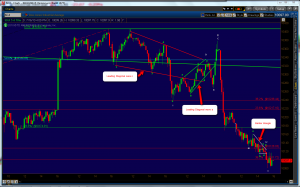This is a very interesting example of leading diagonals. Whenever I spot a diagonal I get excited because it gives me a higher probability interpretation of what to expect from the remainder of the wave sturcture.
A leading diagonal can only occur in two positions of a pattern. P87 of EWP states “A leading diagonal always appers as wave 1 of an impulse or wave A of a Zig-Zag”. This example is unusual because we have both, one after another.
It is important in this example because the wave 1 gave first indication that we were in a trend change. This structure developed after an 800 point advance from the July 2nd lows.
The “a” wave diagonal was confirmation of this change in trend because it followed what appeared to be a 1st wave diagonal and the guidlines state that it can only appear as a corrective wave.
The third wave I have marked on the chart is the barrier triangle. This is important to recognize because “a triangle always occurs in a postition prior to the final actionary wave in the pattern of one degree, ie, as wave four in an impulse”. In this particular situation, the triangle appeared towards the end of a steep selloff and is the best indication that one final wave down was about to occur and to alert you to expect a larger degree correction of the five waves down. One of the guidelines to learn is that the length of the fifth wave is generally the length of the widest part of the triangle. In this case the wave v projection was 46 points. It just so happened that the v exceeded expectations by five points. Not bad huh.
Hopefully this has provided you with some insight to the value of recognizing wave patterns and their ability to profit from this recognition.

No Responses to “Diagonal Wave Patterns” Leave a reply ›